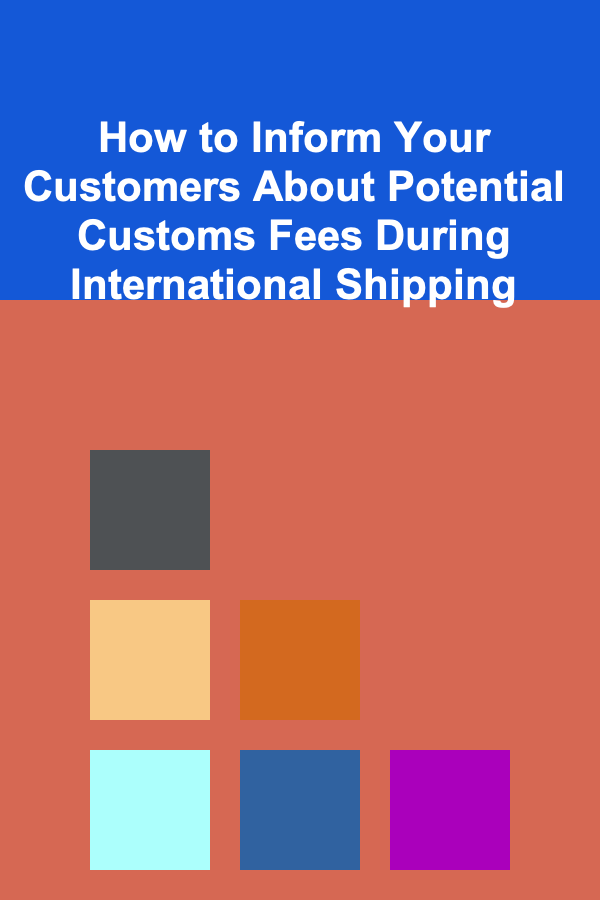
How to Inform Your Customers About Potential Customs Fees During International Shipping
ebook include PDF & Audio bundle (Micro Guide)
$12.99$9.99
Limited Time Offer! Order within the next:

When you're shipping internationally, there's a complex web of logistics, regulations, and fees that come into play, especially customs duties and taxes. One of the most important aspects of international shipping is understanding how to inform your customers about potential customs fees. These unexpected costs can be a surprise for buyers who aren't prepared for them, leading to dissatisfaction and potentially lost business. Therefore, clear communication is essential for maintaining a positive customer experience.
This guide will walk you through actionable steps to effectively inform your customers about potential customs fees, helping you avoid disputes, confusion, and unhappy buyers.
Understand Customs Duties and Taxes
Before informing your customers about customs fees, it's crucial to understand what they are and how they work. Customs duties are taxes imposed by a government on goods that are imported or exported across international borders. These charges vary depending on:
- The destination country: Different countries have different customs policies.
- The value of the goods: Higher-value items tend to incur higher fees.
- The type of product: Certain categories, like electronics or luxury goods, may have higher rates.
- The shipping method: Express shipping methods might attract additional charges.
Customs duties and taxes are often out of the hands of both the seller and the buyer, so it's important to make your customers aware of these possible fees before they place an order.
Be Transparent in Product Listings
One of the most effective ways to inform your customers about potential customs fees is through clear communication at the point of sale. Here's how you can do it:
A. Add a Notice in the Product Description
Include a note in your product description that informs international customers that they may be subject to additional customs fees upon arrival. For example:
"Please note: International customers may be subject to customs duties and taxes based on the laws of their destination country. These fees are not included in the price of the product and are the responsibility of the buyer."
This will set expectations early on and reduce the chances of customers being caught off guard.
B. Use Clear Shipping Terms
Your shipping policy should explicitly mention that customs duties may apply. Include this statement in your terms and conditions or shipping policy page and provide it to your customers at checkout. A sample statement could be:
"International orders may incur additional customs duties, taxes, or other fees that are the responsibility of the recipient. We are not responsible for any delays or additional charges resulting from customs processing."
Include Customs Fee Information During Checkout
While it's important to inform customers early in the process, the checkout phase is where you need to remind them again. Here's how to do that:
A. Customs Fee Disclaimer at Checkout
As part of the checkout process, include a reminder that customs fees may apply. This can be a checkbox or a message right before they confirm the purchase, such as:
"By completing this purchase, you acknowledge that any customs duties or taxes applied by the destination country are your responsibility."
This ensures that customers understand they are agreeing to these terms before they finalize their order.
B. Estimated Customs Duty Calculators
Some e-commerce platforms or third-party tools offer customs duty calculators that estimate the customs fees based on the destination and the products being shipped. Offering a link to such a tool can empower customers to have a more informed purchasing experience. For instance:
"Click here to check an estimate of potential customs fees for your country."
Set Up a Dedicated FAQ Section
An FAQ section is an excellent resource for addressing common customer concerns, and it's the perfect place to include detailed information about customs fees. Address questions such as:
- Why do I have to pay customs fees?
- How much can I expect to pay in customs fees?
- How can I find out the exact amount of customs duties?
- Who is responsible for customs fees?
Example FAQ entry:
Q: Why am I being charged customs fees?
A: Customs duties are taxes imposed by the destination country on imported goods. These fees are outside of our control and vary depending on the value and type of product, as well as the country of delivery.
Provide a Clear Return and Refund Policy for Customs Fees
It's inevitable that some customers will try to return an item if they didn't expect to pay hefty customs fees. To avoid potential disputes, it's wise to have a clear return and refund policy that explicitly states that customs fees are non-refundable. Here's an example:
"Please be advised that we cannot refund any customs duties or taxes paid on international orders. These fees are collected by the government of your country, and we do not have control over them."
Additionally, let customers know that if they refuse delivery due to customs fees, you may not be able to offer a full refund, as the costs incurred by the shipping provider for return shipping and customs processing are typically non-refundable.
Send Shipping Notifications with Customs Information
Once an order has shipped internationally, make sure to send your customers timely notifications with tracking information. Include a note that customs clearance may take extra time and that they should be prepared for the possibility of customs fees upon arrival.
Here's a sample shipping notification message:
"Your order has been shipped! Please note that once your package reaches your country, it may be held by customs for clearance, which could result in additional fees. The buyer is responsible for any customs duties, taxes, or fees that apply."
Providing this information ahead of time reduces uncertainty and allows customers to be prepared for any fees they might encounter.
Consider Using DDP (Delivered Duty Paid) Shipping
If you want to avoid the confusion surrounding customs fees altogether, you can offer DDP (Delivered Duty Paid) shipping. With DDP, the seller (you) are responsible for paying the customs duties and taxes upfront, meaning your customers don't have to worry about paying any additional fees upon delivery. This service can be a bit more expensive, but it offers a hassle-free experience for your customers, making it an attractive option.
If you decide to offer DDP, be sure to clearly communicate this to your customers on your website and during the checkout process:
"We offer Delivered Duty Paid (DDP) shipping, meaning all customs duties and taxes are included in the price of your order. No additional fees will be charged upon delivery."
Leverage Customer Support for Additional Clarity
Sometimes, despite all the information provided, customers will still have questions or concerns about potential customs fees. Make sure your customer service team is well-trained and prepared to address these inquiries.
Provide your support team with a clear script or guidelines to address customs-related questions, such as:
- Explain customs fees in simple terms: "Customs fees are taxes that the destination country charges on goods brought into their country. These fees vary depending on your country's laws and the value of your purchase."
- Be proactive: If a customer reaches out with concerns about their order being delayed or held up in customs, provide them with relevant shipping and tracking information.
Regularly Update Your Information
Customs regulations can change, so it's important to regularly update your product listings, shipping terms, and FAQs to reflect any changes in international shipping policies or customs duties. Stay informed about any updates that may affect your customers, especially for high-demand markets.
- Monitor changes in customs regulations: Different countries adjust their customs policies over time, so keep track of those updates, particularly for the countries where you have the most international customers.
- Adjust pricing and policies accordingly: If you notice a shift in customs fees or other regulatory changes, update your website and shipping policies to reflect these changes and avoid confusion.
Conclusion
Informing your customers about potential customs fees during international shipping may seem like a challenging task, but with clear communication and proper planning, you can ensure that your customers are fully aware of what to expect. By being transparent on your product pages, during checkout, and through regular communication, you can mitigate any misunderstandings and provide a smooth international shopping experience. Taking these steps will not only help you avoid disputes but also foster trust and satisfaction among your international customers.
Reading More From Our Other Websites
- [Home Soundproofing 101] How to Choose Between Sound Dampening and Sound Blocking for Effective Noise Control
- [Home Rental Property 101] How to Select Rental Properties for Students That Balance Affordability and Amenities
- [Home Soundproofing 101] How to Soundproof Doors for Better Noise Control and Privacy
- [Home Security 101] How to Use Surveillance Cameras to Enhance Your Home Security
- [Home Staging 101] How to Stage Your Home When You're on a Tight Timeline
- [Personal Financial Planning 101] How to Navigate Student Loan Repayment and Forgiveness Programs
- [Paragliding Tip 101] From Beginner to Pro: Essential Gear for Safe Thermal Soaring
- [Biking 101] How Bike Cassettes Can Improve Your Cycling Performance
- [Organization Tip 101] How to Compile a Recipe Book from Online Sources
- [Organization Tip 101] How to Use Wall-Mounted Racks for Efficient Garage Storage

How to Engage Kids with STEM Activities at Home
Read More
How to Organize an Intimate Gathering with Minimal Effort
Read More
How to Use Rugs to Define Spaces and Add Warmth on a Budget
Read More
10 Tips for Mastering CAT Tools as a Translator
Read More
How to Grow Microgreens Indoors
Read More
10 Tips for Mastering SIEM Tools as a Security Analyst
Read MoreOther Products

How to Engage Kids with STEM Activities at Home
Read More
How to Organize an Intimate Gathering with Minimal Effort
Read More
How to Use Rugs to Define Spaces and Add Warmth on a Budget
Read More
10 Tips for Mastering CAT Tools as a Translator
Read More
How to Grow Microgreens Indoors
Read More